An easy guide on How To Make Khoya (Homemade Mawa) in the microwave with two simple ingredients - ricotta cheese and ghee. Make this rich milk fudge in a fraction of the time! Use it as the base for Indian sweets for Holi, Diwali or any celebration!
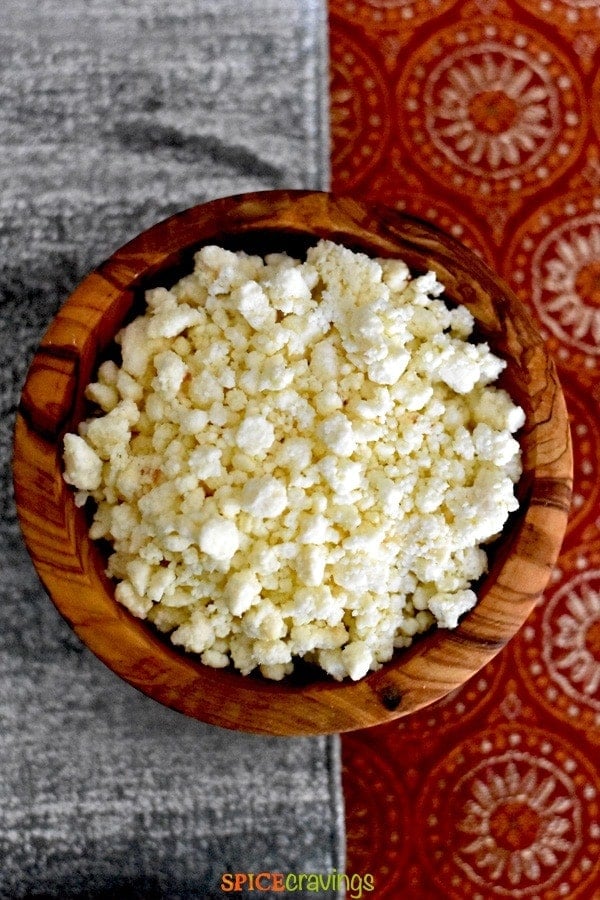
Khoya Recipe - Homemade Mawa
I was at my local Indian market the other day and I happened to pass by Khoya in the frozen food section. And it occurred to me that many of my readers ask me about a homemade version of Khoya since it is so hard to find in most supermarkets. So I thought to give it a try.
The process of making Khoya, also known as Mawa, is actually very easy, but it is time-consuming.
This recipe is super quick! It is made at home in the microwave with two simple ingredients - ricotta cheese and ghee!
Since the Indian festival, Holi, is coming up next week, I thought this to be an appropriate time! This makes Mithai (sweets) even more enjoyable since the Khoya base is fresh and homemade. Checkout these Baked Gujiyas that I make with this Khoya.
Meaning Of Hindi Word Khoya In English
Khoya quite literally translates to Curd in English. It is also referred to as Khoa in some places.
What is Khoya
Khoya is dried evaporated milk solids commonly used in sweet Indian desserts, particularly in the Northern region of India. Khoya (or Mawa) is made of either dried whole milk or milk thickened by heating it in an open iron pan. But today, we are making it quick and easy in the microwave!
Is Paneer And Khoya The Same Thing?
Both Paneer and Khoya are milk derivatives, but they are produced by treating milk differently.
Paneer (or Chenna) is Indian cottage cheese that is made by curdling milk with an acid, such as lemon juice or vinegar. The milk solids are then set to drain and firm up in a muslin cloth. The consistency can range from soft to firm depending on the length of time you allow it to drain. Paneer is traditionally used in savory Indian curries.
Khoya, on the other hand, is made by slowly simmering milk in a large iron Kadai (cast iron deep pan with steep sides) until all the moisture evaporates and reduces to solids. It can range from being hard to soft to granular and forms a base of almost all Indian sweets.
What Does Khoya Taste Like?
Since it is milk that is evaporated to a solid consistency by thickening it, it has a slightly oily and granular texture, and a rich, nutty flavor.
Ingredients For Khoya
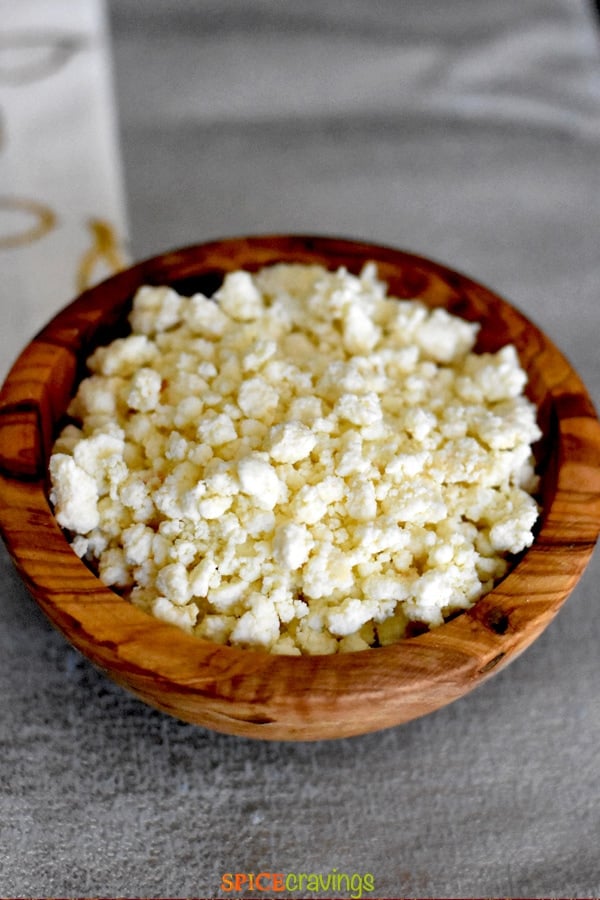
All you need are two simple ingredients to make homemade Khoya in the microwave!
- Ricotta Cheese: It is best to purchase a whole milk ricotta cheese to get the right consistency. This is milk fudge, after all, so we want full-fat! I sometimes like to take a trip to my local Italian market, since they have the freshest ricotta cheese available.
- Ghee: A small teaspoon of ghee (clarified butter) is all you need to grease the bowl. Ghee can easily be found nowadays at Trader Joe's, Whole Foods or even online.
How To Make Khoya From Ricotta Cheese
The step-by-step guide on making khoya from ricotta cheese takes a fraction of the time as compared to the traditional method. Simply follow the microwave directions below.
How To Make Khoya In Microwave
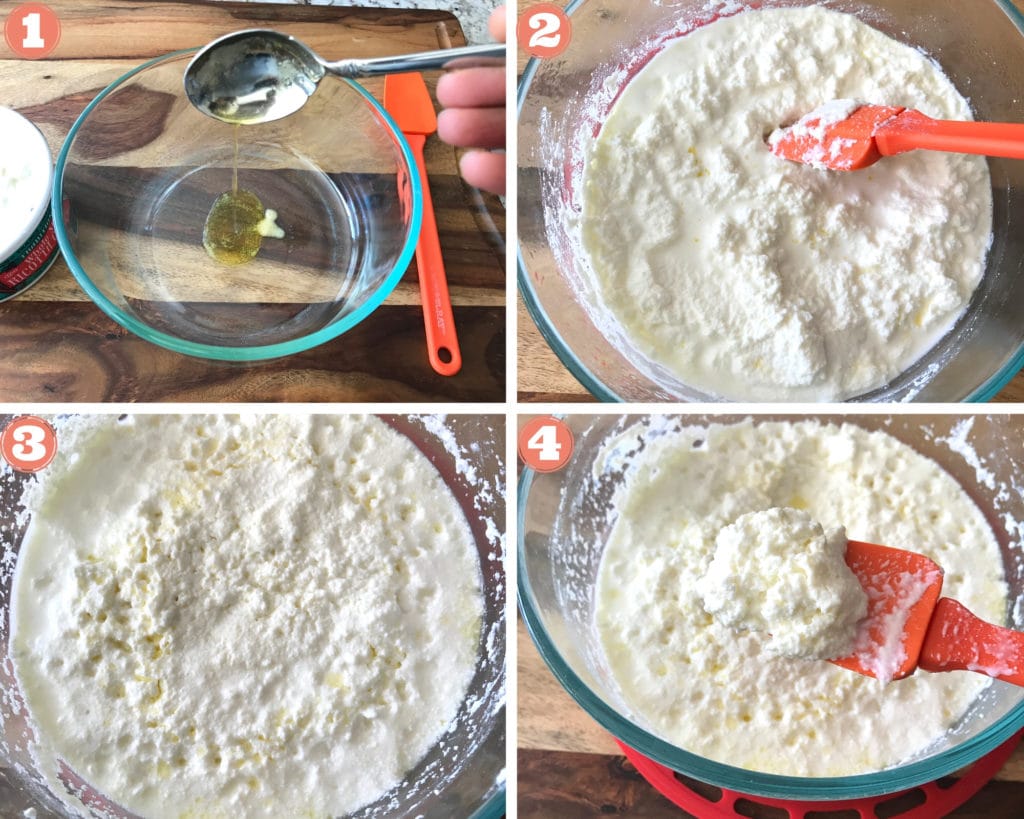
- Grease a large microwave-safe bowl with ghee (Pic 1).
- Add ricotta cheese and stir. Microwave it at regular heat setting for 2 minutes. At this point, the ricotta mix looks like a wet batter (Pics 2-4).
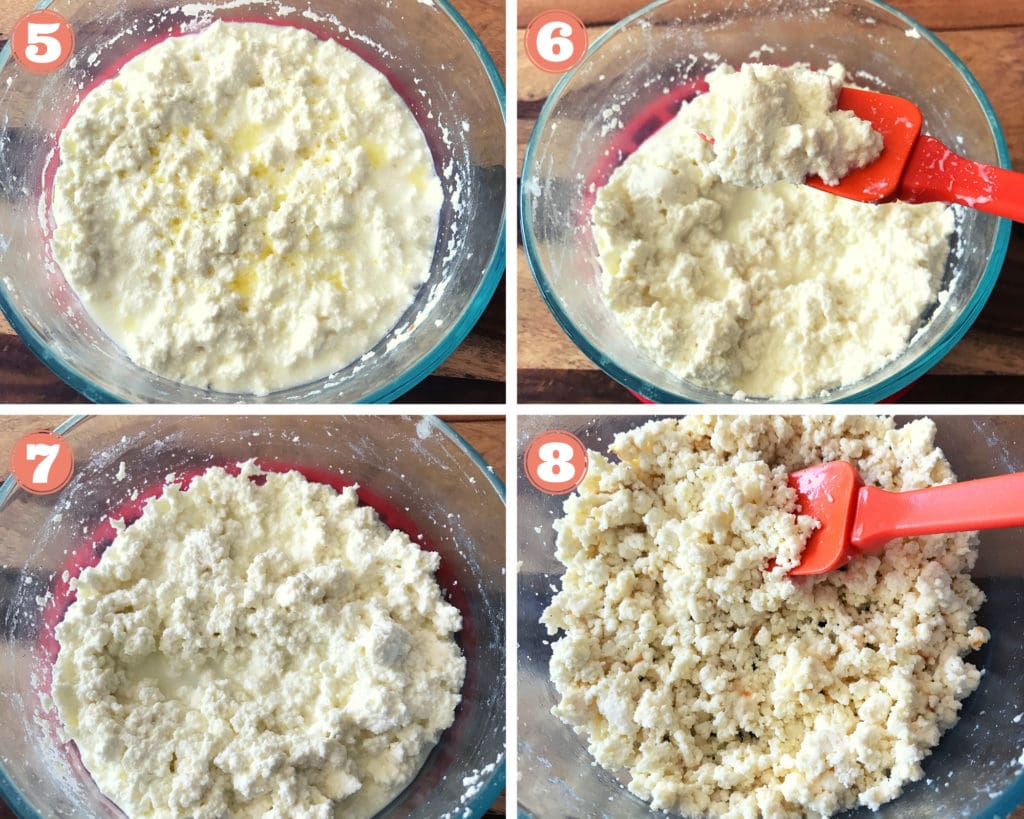
- Remove and give it a stir. Put it back in for another 2 minutes. Repeat 2 more times, microwaving it for a total of 8 minutes (Pics 5 & 6).
- Stir and microwave this mix in 1-minute increments, stirring well in between (Pic 7).
- Repeat this another 4-5 times, until all the moisture from the ricotta has evaporated and the ricotta curdles are semi-dry. This takes anywhere from 5-6 minutes (Pic 8).
How To Make Mawa From Milk Powder
Another short-cut to this sweet Indian filling is mawa made from milk powder. I like to think of this method as an Instant Mawa recipe. Simply:
- Place 2 cups of full-fat milk powder in a bowl.
- In a small saucepan, add 1 Tablespoon ghee and ½ cup whole milk. Heat the mixture until it just comes to a boil, stirring occasionally to prevent the milk from burning.
- Add the hot ghee-milk mixture to the milk powder and mix it with a spoon. It should start to come together after a few strokes. If it seems dry, add 1 teaspoon milk at a time. If the mixture becomes too sticky, add 1 Tablespoon milk powder at a time.
- Shape the Instant mawa into whatever shape you prefer (I like a circular shape) while it is still warm and let it cool. It will harden after cooling. Grate or crumble it as needed.
Different Kinds Of Mawa or Khoya:
- Hard Khoya - Also known as Batti (meaning brick), is very firm and solid, which is great for crumbling or grating. It is made by reducing the ricotta cheese to ⅕th of its original volume. The frozen Khoya at the Indian Store falls in this category.
- Soft Khoya - also known as Chikna Mawa. Stop reducing the ricotta cheese 1-2 minutes earlier than mentioned in the recipe card. Soft mawa is typically added to royal curries, like Khoya paneer, Shahi Kofta.
- Granular Khoya - also known as Danedar Mawa. This has moderate moisture content, which makes it ideal for making sweets like Burfi, Kalakand etc.
How To Store
If you're not planning on using your khoya right away, allow it to cool completely. Once cooled, knead the crumbles into a smooth dough and place in an airtight container.
The homemade mawa will keep best in the fridge for 3-4 days or stored in the freezer for up to 2 months.
To Thaw And Use
If frozen, thaw the khoya overnight in the refrigerator.
When ready to use, remove from the fridge and crumble it with a fork while still cold. The khoya is now ready to use in all your Mithai recipes!
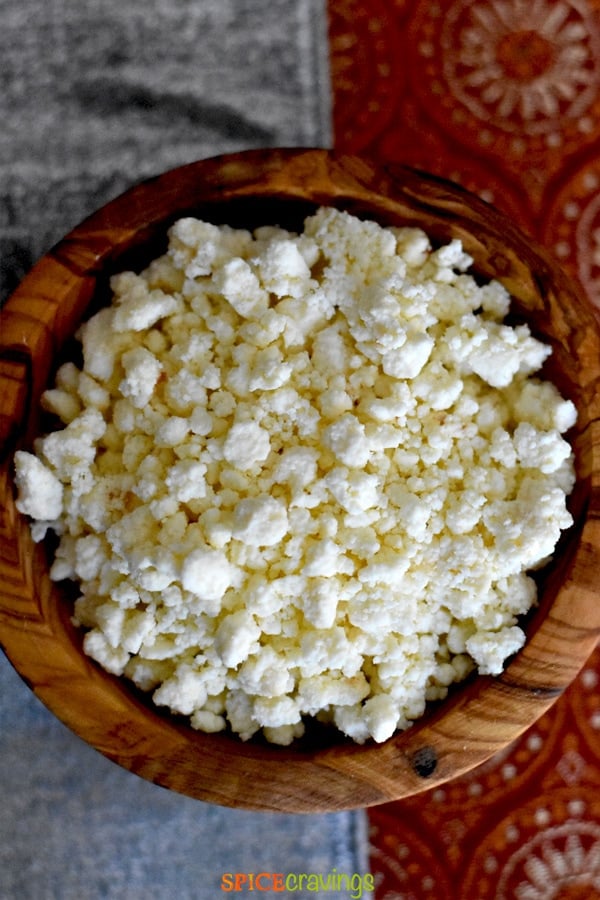
Recipe Tips For Homemade Mawa/Khoya:
- The key to a perfect mawa is to keep stirring. This prevents the milk solids from burning in the microwave.
- If you decide to half, double or triple the recipe, cooking time may vary. Follow the visual in the photos above to ensure you are evaporating the milk to the right texture.
Indian Sweet Dishes with Khoya
Khoya is the base of many North Indian sweets, especially those made around the time of Indian festivals such as Holi and Diwali. A few of my family's favorites include: Gujiya, Rabri, Carrot Halwa, Kala Jamuns, Peda, Gulab Jamuns, just to name a few.
Occasionally, Khoya can also be used to make savory dishes such as gravies or curries.
Indian Recipes From My Kitchen
More Indian Desserts From My Kitchen
- Sooji Sheera | Semolina Pudding
- Kesar Badam Halwa | Saffron Almond Pudding
- Besan Laddoo
- 10-Minute Coconut Laddoo
- Gajar Burfi | Carrot Fudge
- Gajar ka Halwa
- Kheer | Rice Pudding
- Nankhatai | Almond Spice Cookies
★ Did you make this recipe? Please give it a star rating below! For more quick & easy recipes, FOLLOW ME on Facebook, Instagram, Pinterest and Youtube.
📖 Recipe
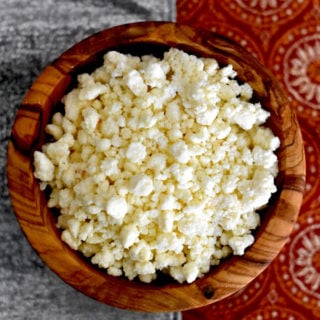
Khoya Recipe | Homemade Mawa
Ingredients
- 16 oz Ricotta Cheese whole milk
- 1 teaspoon Ghee
Instructions
- Grease a large microwave safe bowl with ghee.
- Add ricotta cheese and stir. Microwave it at regular heat setting for 2 minutes. At this point the ricotta mix looks like a wet batter.
- Remove and give it a stir. Put it back in for another 2 minutes. Repeat 2 more times, microwaving it for a total of 8 minutes.
- Stir and microwave this mix in 1-minute increments now, stirring well in between.
- Repeat this another 4-5 times, till all the moisture from ricotta has evaporated and the ricotta curdles are semi-dry. This takes anywhere from 5-6 minutes. Khoya/Mawa is ready for use.
Storing
- If storing Mawa for later, wait for it to cool down. Knead the crumbles into a smooth dough. Store it in an airtight container and refrigerate or freeze for later use.
Thaw and Use
- Thaw the Khoya overnight in the refrigerator. Crumble it using a fork and it's ready to use.
Notes
- The key to a perfect Khoya/Mawa is to keep stirring. This prevents the milk solids from burning in the microwave.
- If you decide to half, double or triple the recipe, cooking time may vary. Follow the visual in the photos above to ensure you are evaporating the milk to the right texture.


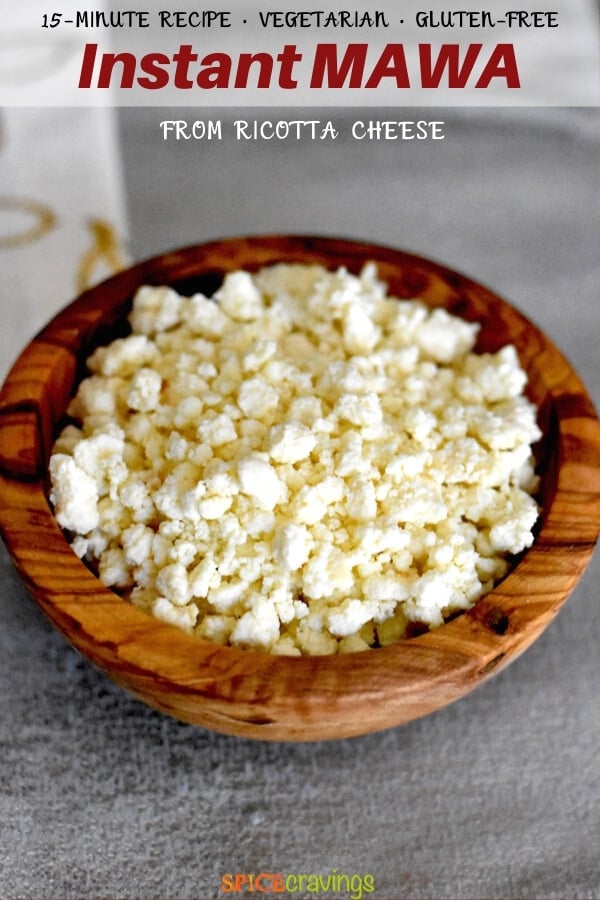
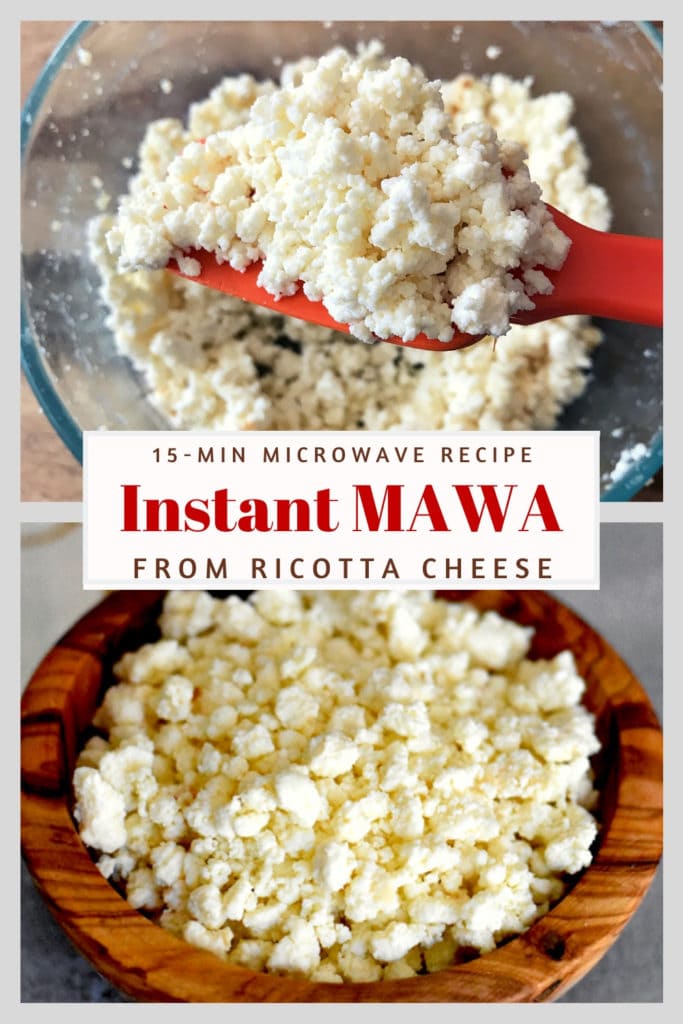
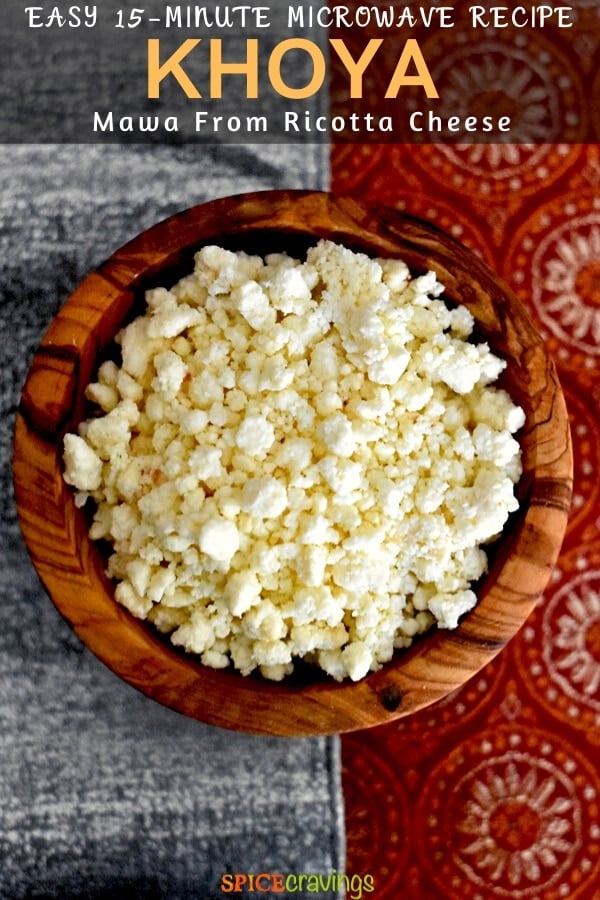
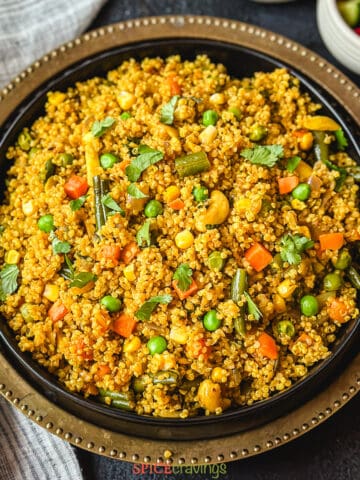
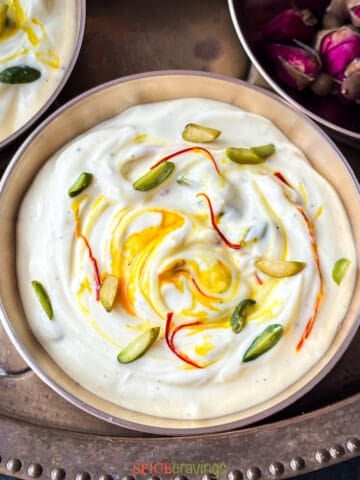
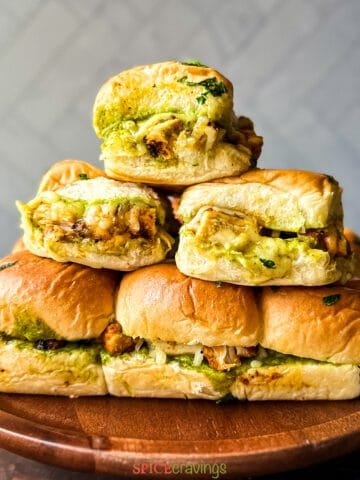
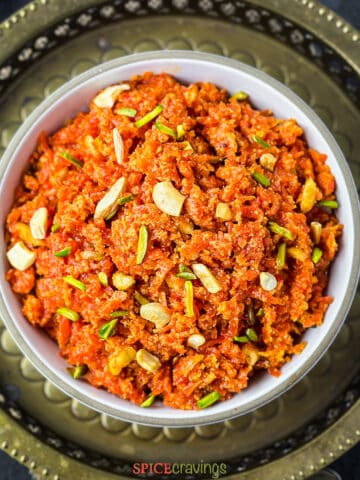

Betty says
Hello! I will be making Galub Jamun for the first time, which would be best suited for that recipe? Thanks
Aneesha says
Hi Betty, I'm not sure I follow your question. Are you asking how to make gulab jamun with this khoya?
KD says
What is alum to make it danedaar
Aneesha says
Hi There, I'm not sure I follow the question. This recipe results in a 'danedaar' texture though. Hope you try it!
Sharmila says
Khoyalicious!??
Aneesha says
You bet 🙂 Thank you!